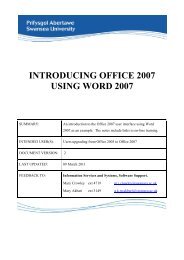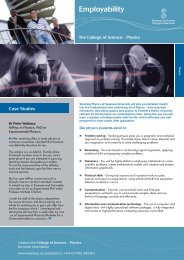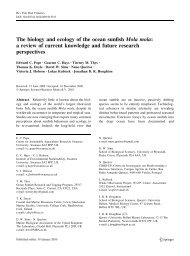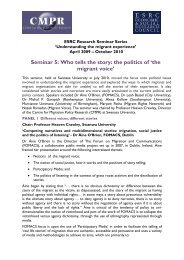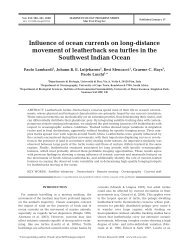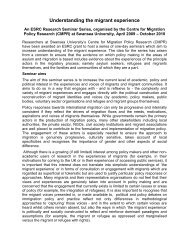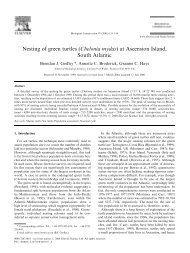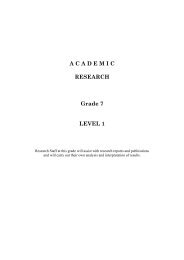The energy density of jellyfish - Swansea University
The energy density of jellyfish - Swansea University
The energy density of jellyfish - Swansea University
You also want an ePaper? Increase the reach of your titles
YUMPU automatically turns print PDFs into web optimized ePapers that Google loves.
T.K. Doyle et al. / Journal <strong>of</strong> Experimental Marine Biology and Ecology 343 (2007) 239–252<br />
249<br />
tissues derived from bomb-calorimetry (p b0.001).<br />
<strong>The</strong>re was no difference between these two regression<br />
lines (t =0.9351, df 59). <strong>The</strong> relationship between<br />
revised ash content and <strong>energy</strong> <strong>density</strong> <strong>of</strong> individual<br />
tissues from both methods combined, gave the following<br />
equation: Energy <strong>density</strong> (kJ g wet mass − 1 )=1.21–<br />
0.0132 (% revised ash), r 2 =0.847, pb0.001 (Fig. 2).<br />
<strong>The</strong>re was no difference between the regression lines <strong>of</strong><br />
‘whole’ <strong>jellyfish</strong> samples and ‘tissue’ samples, such that<br />
the equation above can be used to determine the <strong>energy</strong><br />
<strong>density</strong> for whole <strong>jellyfish</strong> samples.<br />
<strong>The</strong> revised mean bomb-calorimetry values for whole<br />
<strong>jellyfish</strong> equate to 0.18, 0.11, 0.10 kJ g wet mass − 1 , for<br />
C. capillata, R. octopus, and C. hysoscella respectively.<br />
<strong>The</strong> revised mean proximate-composition values for<br />
whole <strong>jellyfish</strong> equate to 0.20, and 0.12 kJ g wet mass − 1 ,<br />
for C. capillata and R. octopus respectively.<br />
4. Discussion<br />
Estimating the <strong>energy</strong> <strong>density</strong> <strong>of</strong> <strong>jellyfish</strong> is not<br />
straightforward, but our results help resolve some <strong>of</strong> the<br />
problems associated with different approaches (Lutcavage<br />
and Lutz, 1986; Arai, 1997). We can consider our<br />
revised proximate-composition estimates to be close to<br />
the true <strong>energy</strong> <strong>density</strong> <strong>of</strong> <strong>jellyfish</strong> because, (1) this<br />
method accounted for the bound water <strong>of</strong> hydration, and<br />
(2) subsequently, when the sum <strong>of</strong> all measured<br />
fractions were added they equalled ∼100% <strong>of</strong> DM.<br />
Hence the revised values from proximate-composition<br />
Table 6<br />
Gross <strong>energy</strong> (GE) <strong>density</strong> values <strong>of</strong> different foodstuffs (expressed as kJ g dry weight − 1 and as kJ g dry mass − 1 when available)<br />
Feedstuff/tissue Species GE kJ g dry<br />
mass − 1<br />
GE kJ g wet Comment Source<br />
mass − 1<br />
Red algae Gelidium and 13.8±2.1 Based on stomach contents <strong>of</strong> marine iguanas Wikelski et al. (1997)<br />
Centroseras<br />
Green algae Ulva species 10.0±2.7 Based on stomach contents <strong>of</strong> marine iguanas Wikelski et al. (1997)<br />
Sea grass Thalassia species 14 Bjorndal (1997)<br />
Sponge 16 Bjorndal (1997)<br />
Hydrozoan Calycopsis<br />
4.79 Calculated from carbon content Clarke et al. (1992)<br />
borchgrevinki<br />
Hydrozoan Botrynema brucei 1.96 Calculated from carbon content Clarke et al. (1992)<br />
Siphonophores Diphyes antarctica 2.98 Calculated from carbon content Clarke et al. (1992)<br />
Pyrosomas Pyrosoma atlantica 4.96±1.56 0.31±0.07 Proximate-composition Davenport and Balazs<br />
(1991)<br />
Jellyfish Atolla wyvillei 5.95 Calculated from carbon content Clarke et al. (1992)<br />
Jellyfish Aurelia aurita 2.3–3.6 Arai (1997)<br />
Jellyfish Pelagia noctiluca 3.1–4.1 Arai (1997)<br />
Jellyfish Cyanea capillata 4.22±0.98 0.18±0.05 Based on corrected bomb-calorimetry estimates This study<br />
Jellyfish Chrysaora hysoscella 2.42±0.68 0.10±0.03 Based on corrected bomb-calorimetry estimates This study<br />
Jellyfish Rhizostoma octopus 2.80±1.05 0.11±0.04 Based on corrected bomb-calorimetry estimates This study<br />
Ctenophore Beroe ovata 2.7±0.4 0.07 Finenko et al. (2001)<br />
Ctenophore Pleurobrachia 0.47 Calculated from carbon content Clarke et al. (1992)<br />
Ctenophore Beroe sp. 4.33 Calculated from carbon content Clarke et al. (1992)<br />
Polychaete Tomopteris carpenteri 16.33 Calculated from carbon content Clarke et al. (1992)<br />
Squid 20.71±0.95 3.81±0.24 Van Pelt et al. (1997)<br />
Salp Salpa fusiformis 5.45 Calculated from carbon content Clarke et al. (1992)<br />
Adult sand lance Ammodytes hexapterus 14.23–22.79 Robards et al. (1999)<br />
Sandeels Ammodytes marinus 5.8±0.5 Samples taken from guillemot regurgitates Wanless et al. (2005)<br />
Sprat Sprattus sprattus 7.6±0.7 Samples taken from guillemot regurgitates Wanless et al. (2005)<br />
Flatfish 16.5±0.23 3.61±0.01 Anthony et al. (2000)<br />
Pacific cod Gadus marcocephalus 17.1±0.22 3.65±0.08 Anthony et al. (2000)<br />
Pacific herring Clupea harengus 21.3±0.19 5.84±0.11 Anthony et al. (2000)<br />
pallasi<br />
Myctophid fish E.g. Krefftichtys spp. 24.1 6.9 Obtained from stomach samples <strong>of</strong> birds Kooyman et al. (1992)<br />
Various fish From north Pacific 15.57–27.92 2.37–8.05 Van Pelt et al. (1997)<br />
Typical<br />
17.5 Clarke et al. (1992)<br />
carbohydrate<br />
Typical lipid 39.5 Clarke et al. (1992)<br />
Typical protein 23.9 Clarke et al. (1992)<br />
Foliage Eucalyptus mix 21.05 7.9 Ullrey et al. (1981)



